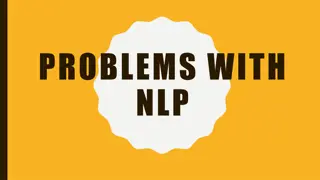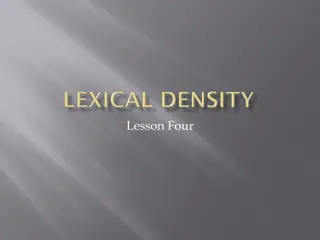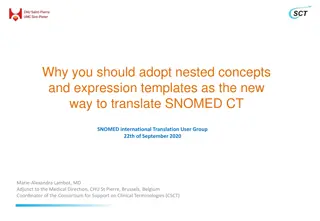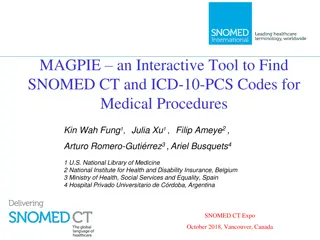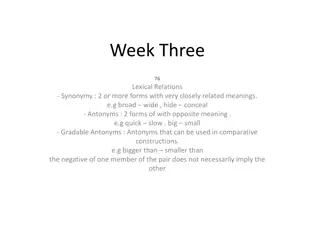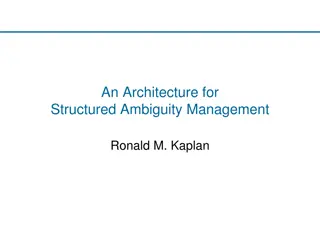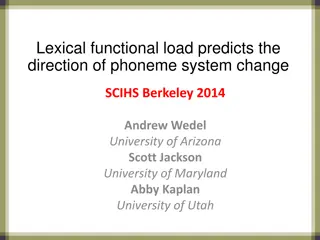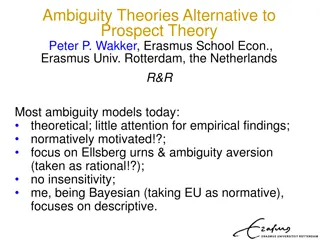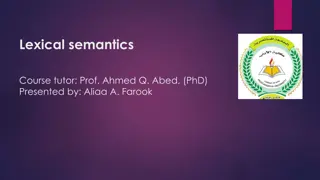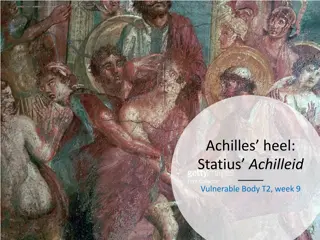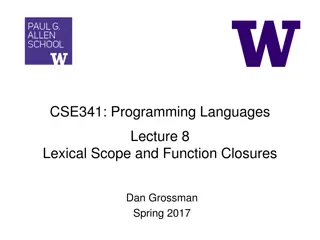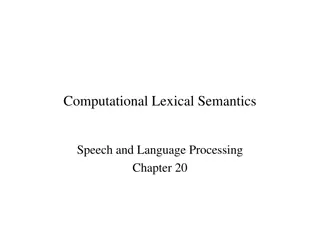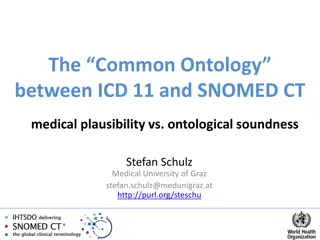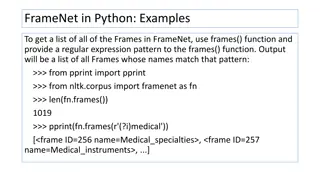
Lexical Ambiguity in Life Sciences: SNOMED CT in Focus
Explore the intricacies of lexical ambiguity in SNOMED CT within life sciences, covering ontology labels, interface terms, and term popularity based on PubMed data. Understand the distinction between terms and concepts in a nutshell.
Download Presentation

Please find below an Image/Link to download the presentation.
The content on the website is provided AS IS for your information and personal use only. It may not be sold, licensed, or shared on other websites without obtaining consent from the author. If you encounter any issues during the download, it is possible that the publisher has removed the file from their server.
You are allowed to download the files provided on this website for personal or commercial use, subject to the condition that they are used lawfully. All files are the property of their respective owners.
The content on the website is provided AS IS for your information and personal use only. It may not be sold, licensed, or shared on other websites without obtaining consent from the author.
E N D
Presentation Transcript
ODLS 2017 Ontologies & Data in Life Sciences Lexical ambiguity in SNOMED CT Stefan Schulz Catalina Mart nez-Costa Jose Antonio Mi arro-Gim nez Institute for Medical Informatics, Statistics and Documentation, Medical University of Graz, Austria
Background SNOMED CT: largest clinical terminology / ontology (English: 300 k concepts, 750k terms) Two aspects: SNOMED CT as a domain ontology: Labels (FSNs), tentatively self-explaining; formal descriptions and definitions (EL++), still few free text elucidations SNOMED CT as a domain terminology: at least for English, enrichment with quasi-synonyms ("interface terms") SNOMED International (aka IHTSDO). SNOMED CT http://www.snomed.org/snomed-ct
Ontology labels vs. Interface terms Labels Self-explaining Univocal Long Unabridged Unpopular Should be understandable independent of contex Interface terms Not self-explaining Ambiguous Short Abridged (Acronyms) Popular Depend on user groups, by specialty, institution, dialect "Primary malignant neoplasm of lung" "Leishmania tropica" "Electrocardiogram" "Diagnosis" "Ca Lung " "LT" "ECG" "Dx"
Popularity of terms (Pubmed titles and abstracts) FSN (SNOMED CT) Count SNOMED CT synonyms Count Primary malignant neoplasm of lung Lung cancer Bronchial carcinoma 120682 3452 0 Cerebrovascular accident 3819 Stroke 191559 Block dissection of cervical lymph nodes 1 Neck dissection 7512 Electrocardiographic procedure Electrocardiogram ECG 33670 55120 1 Backache 3489 Back pain 38132 Capillary blood specimens 32 Capillary blood samples 574
Lexical ambiguity in a nutshell "Term" and "concept" are two fundamentally different things: Concepts/classes/types/categories: units of language-independent meaning (Natural language) Terms: units of language, connected to concepts "financial institution" "bank" "riverside" Concept 1 Concept 2
Main questions Why should ontologies care about ambiguity aspects at all when studying ontology? User acceptance of ontology-based systems Quality of structured data entry Use of ontology in NLP scenarios How is lexical ambiguity related to the ontology issues proper? Completeness and quality of ontology content Complex categories
Understanding better SNOMED CT naming Fully specified names Unique 1 : 1 relation with codes Carry a "hierarchy tag" Without hierarchy tag (e.g. for term matching in texts), ambiguity may arise: Lymphoma (disorder) vs. Lymphoma (morphology) Synonyms May be ambiguous Short forms Entries not ambiguous because accompanied by expanded form, e.g. PIN - Prostatic intraepithelial neoplasia Pressure-induced nystagmus
Scrutiny of ambiguous terms in SNOMED CT SNOMED CT January 2017 release: Extract ambiguous entries Full terms (without hierarchy tags) D1 Acronyms (without abbreviations) D2 Analysis: Count ambiguities and their cardinality SNOMED CT hierarchies to which ambiguous terms belong Ambiguous terms that are related via non-taxonomic links (e.g. Associated morphology or Has active Ingredient) Ambiguous terms that are related via taxonomic links (is-a) Purpose: Detect regularities, spot errors, derive recommendations to SNOMED Intl.
Results: Frequency and Distribution Results Frequency and distribution of ambiguous readings of SNOMED CT terms Dictionary Count Maximum Cardinality Mean Median 2.02 5.54 D1 (non-acronym terms) D2 (acronyms) 7,439 899 2 2 6 1678
Results Results D1 Leading patterns of concept tuples connected by the same SNOMED CT (non-acronym) term Hierarchy tag combination patterns | product | substance | | disorder | morphologic abnormality | | organism | organism | | procedure | substance | | procedure | procedure | Other n-tuples (2 n 6) Strict implications, e.g. 'Folinic acid (product)' subclassOf 'Has active ingredient' some 'Folinic acid (substance)' "Dot types" (logical polysemy) 'Solar keratosis (disorder)' subclassOf 'Associated morphology' some 'Solar keratosis (morphologic abnormality)' Pattern count 4,064 1,047 221 213 200 1,694 Rate of non- taxonomic links Rate of taxonomic links 0.888 0.707 0.000 0.911 0.000 0.000 0.000 0.452 0.000 0.465 Arapinis A,Vieu L (2015). A plea for complex categories in ontologies. Applied Ontology, 10(3-4), 285-296.
Results Results D2 Leading patterns of concept tuples linked by the same acronym extracted from SNOMED CT terms Hierarchy tag combination Patterns | disorder | disorder | | disorder | procedure | | procedure | procedure | | procedure | substance | | disorder | substance | Other n-tuples (2 n 1678) Pattern count Rate of non- taxonomic links Rate of taxonomic links 66 59 38 33 28 675 0.015 0.034 0.000 0.333 0.000 0.167 0.000 0.263 0.000 0.000 Distribution of patterns much more evely Acronym naming pattern not specific: e.g., O/E eye, O/E nose, O/E mouth, O/E heart etc.
Conclusion Degree of Lexical ambiguity in SNOMED CT moderate Ontological aspect: ontologically dependent concepts, partly interpretable as complex categories (dot types) Lexical aspect: Amount of ambiguous acronyms lower than expected risk of wrong mappings Naming aspect: Acronym expansion patterns not specific: wrong expansions Should interface terms (synonyms) be managed by the ontology curators?


